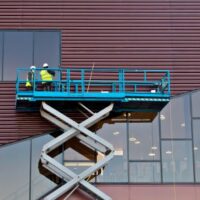Plaintiff Files Lawsuit After Falling From Scissor Lift

A California jury is hearing arguments concerning an allegedly defective chain on a scissor lift that caused a worker to fall from a height of 12 feet. The plaintiff was working on the scissor lift during a major renovation at a hotel while replacing windowpanes. The plaintiff believes that the chain latch did not offer adequate protection and ultimately failed leading to his injuries.
The plaintiffs contend that the scissor lift was defectively designed and did not include a self-latching gate. European models of the same scissor lift require self-latching gates, and the plaintiffs argued that had the company done usage studies on their lifts, their products would also have self-latching gates. In this case, the failure to add a safety device that would be considered industry-standard is at the heart of this lawsuit.
Blame the victim
If you bring a personal injury lawsuit against a major company over their defective product, they will blame you for causing your own injury. Even in cases where the plaintiff is highly sympathetic, the defense benefits from laying at least some of the blame at the plaintiff’s feet. In this case, the defense argued that their scissor lift worked exactly the way it was supposed to, and the defendant simply operated it poorly.
The defense further argued that the lift had adequate safety features including a railed platform that a worker would “literally have to duck under” to fall from. Lastly, the defense argued that the chain latch was simply not employed by the worker which rendered it functionally useless.
Failure to provide safety features
There are several arguments that you can make against a company that designed a product that caused injury. The failure to provide safety features or the failure of those safety features to work are two such arguments you can make. However, the argument is not as strong as saying that the product was defectively designed.
As an example, the trucking industry is required to place underride guards on the back of their trucks. Since the clearance of the truck is about level with your average car’s windshield, a car that gets wedged under a truck is more likely to have a dead driver than a car that bounces off an underride guard. Hence, underride guards are required by federal law, at least on the backs of trucks. Side underride guards are still not required.
Now, you have a problem. The law is not placing a specific burden on the industry to provide a specific safety feature. Since the law does not require the feature, the plaintiff has nothing to compare their case against. They cannot say, “This company skirted regulations.” They can only say, “This company did not provide a safety feature that is not required by law.”
In other words, this will be a tough case for the plaintiff to win. The likely outcome is that the jury returns a verdict in which both parties are ascribed liability, and the plaintiff can recover a percentage of his damages.
Talk to a Tampa Personal Injury Lawyer Today
You can sue third parties for on-the-job injuries, particularly those who manufacture machinery that fails when it’s needed most. Call the Tampa personal injury lawyers at The Matassini Law Firm today and schedule a free consultation. We can begin discussing your case today. Call now!
blog.cvn.com/products-liability-trial-over-fall-from-allegedly-defective-scissor-lift-begins-cvn-recording-gavel-to-gavel
